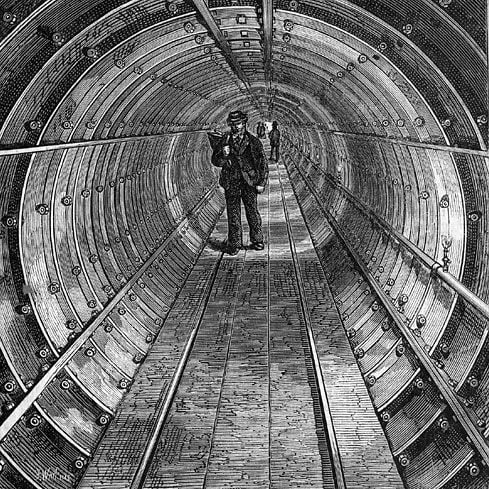19th-Century Londoners Walked Under the Thames in This Creepy Tunnel
The Tower Subway tunnel was only seven feet in diameter
/https://tf-cmsv2-smithsonianmag-media.s3.amazonaws.com/filer/65/d4/65d42cc9-2991-4f86-9c3e-21dcbe56066b/tower_subway_carriage.jpg)
The Tower Subway, which opened on this day in 1870, was the first underground railway to run under a river, and one of the first subways in the world. That’s before it turned into the world’s creepiest pedestrian passage.
Built by Peter Barlow, an engineer, the subway was intended to solve the problem of crossing the Thames for passengers. Above-water crossings in ferries disrupted shipping, writes Stuart Nathan for The Engineer, while a previous attempt to build an underground passenger railway below the Thames hadn’t worked. Barlow’s idea was an improvement over the previous tunnel.
The subway tunnel was 100 feet long and only seven feet across, “lined with cast-iron segments,” Nathan writes. It ran 22 feet below the riverbed. Stationary steam engines at each end of the tunnel pulled a carriage from one side of the river to the other. An image from the Illustrated London News shows passengers seated in a windowless carriage that had a lantern hanging from one end.
If that sounds a bit eerie, it’s nothing to what came after. The steam-powered system was unreliable and as a result the railway closed in December of that year–leaving a tunnel under the Thames. The previous Thames Tunnel had attracted millions of visitors after opening in 1843 as a pedestrian tunnel, but in 1869, that tunnel was running freight under the river, according to The Brunel Museum–leaving a gap in pedestrian transport that couldn't be filled by ferries across the Thames. Because Thames shipping traffic went east-west along the river while ferries went north-south across the river, the ferries were in constant conflict with shipping and couldn't move many people. A bridge over the Thames wouldn't be attempted until the Tower Bridge was built in the 1880s and 90s.

Crossing under the river in the Tower Subway tunnel on foot cost half a penny, writes The Telegraph. This provided an economical route across the river for working-class people.
It was also a curiosity, one which several writers of the period explored and documented. Charles Dickens Jr., the son of the well-known writer, documented in a London guidebook quoted by Nathan that “It is not advisable for any but the very briefest of Her Majesty’s lieges to attempt the passage in high-heeled boots, or with a hat to which he attaches any particular value.” Seven feet at its highest point, the tunnel was cramped to say the least.
Although the thick clay that Barlow tunnelled through ensured that the tunnel remains in place to this day (it’s now used to carry water mains), the prospect of the river crashing in must have been terrifying. Then, as if crossing a poorly-lit, cramped, 100-foot-long tunnel under the river wasn’t enough, some reported seeing a man with a knife in the tunnel in 1888. London was then in the throes of Jack the Ripper hysteria, writes The Telegraph, and this sighting fed it–it didn’t help the tunnel was the perfect setting for a creepy encounter. Italian writer Edmondo de Amicis had described the tunnel in eerie terms only five years earlier:
It is lighted by a row of lights as far as you can see, which shed a veiled light, like sepulchral lamps; the atmosphere is foggy; you go along considerable stretches without meeting a soul; the walls sweat like those of an aqueduct; the floor moves under your feet like the deck of a vessel; the steps and voices of the people coming the other way give forth a cavernous sound, and are heard before you see the people, and they at a distance seem like great shadows; there is, in short, a sort of something mysterious, which without alarming causes in your heart a vague sense of disquiet.
The pedestrian tunnel closed in 1898, after the free (and significantly less disquieting) Tower Bridge was completed.